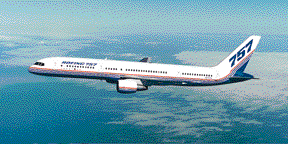 |
|||||
| Home | Research | For Teachers | HISTORY Level 1 Level 2 Level 3 |
PRINCIPLES Level 1 Level 2 Level 3 |
CAREER Level 1 Level 2 Level 3 |
| Gallery | Hot Links | What's New! | |||
| Web Administration and Tools | |||||
 |
|||||
| Home | Research | For Teachers | HISTORY Level 1 Level 2 Level 3 |
PRINCIPLES Level 1 Level 2 Level 3 |
CAREER Level 1 Level 2 Level 3 |
| Gallery | Hot Links | What's New! | |||
| Web Administration and Tools | |||||
![]()
 In this module,
we will study the basics of why an airplane flies and how it is navigated. Although
balloons, dirigibles, and helicopters are also aerospace vehicles, we will confine
ourselves to the modern, fixed-wing airplane with a piston or turbine engine. The airplane
we know today is a machine which evolved from the box-kite structure built by the Wright
brothers. Lying across the bottom wing of their aircraft, they used their bodies for
balance as they glided like the birds. Later, their gliders had a wooden-frame fuselage,
and they added an elevator in the front which they balanced with a rudder in the back.
They then added an engine with two pusher propellers (props were behind the engine). The
first truly successful controlled flight in a heavier-than-air flying machine was made
with this aircraft. As airplanes became streamlined and engines became more powerful, the
propellers were moved forward of the wing. The rudder and elevator became part of the
tail. The fuselage held the pilot, and later it held passengers and cargo. This is the
machine we will study.
In this module,
we will study the basics of why an airplane flies and how it is navigated. Although
balloons, dirigibles, and helicopters are also aerospace vehicles, we will confine
ourselves to the modern, fixed-wing airplane with a piston or turbine engine. The airplane
we know today is a machine which evolved from the box-kite structure built by the Wright
brothers. Lying across the bottom wing of their aircraft, they used their bodies for
balance as they glided like the birds. Later, their gliders had a wooden-frame fuselage,
and they added an elevator in the front which they balanced with a rudder in the back.
They then added an engine with two pusher propellers (props were behind the engine). The
first truly successful controlled flight in a heavier-than-air flying machine was made
with this aircraft. As airplanes became streamlined and engines became more powerful, the
propellers were moved forward of the wing. The rudder and elevator became part of the
tail. The fuselage held the pilot, and later it held passengers and cargo. This is the
machine we will study.
Send all comments to ![]() aeromaster@eng.fiu.edu
aeromaster@eng.fiu.edu
© 1995-98 ALLSTAR Network. All rights reserved worldwide.
| Funded in part by | From Civil Air Patrol Educational Materials |
Updated: February 23, 1999